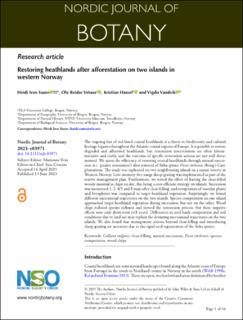Restoring heathlands after afforestation on two islands in western Norway
Journal article, Peer reviewed
Published version

Åpne
Permanent lenke
https://hdl.handle.net/11250/3077121Utgivelsesdato
2023Metadata
Vis full innførselSamlinger
- Department of Geography [627]
- Registrations from Cristin [9489]
Sammendrag
The ongoing loss of red-listed coastal heathlands is a threat to biodiversity and cultural heritage legacies throughout the Atlantic coastal regions of Europe. It is possible to restore degraded and afforested heathlands, but restoration interventions are often labour-intensive and costly, and the outcome of specific restoration actions are not well documented. We assess the efficiency of restoring coastal heathlands through natural succession (i.e. ‘passive restoration') after removal of Sitka spruce Picea sitchensis (Bong.) Carr. plantations. The study was replicated on two neighbouring islands in a nature reserve in Western Norway. Low-intensity free-range sheep grazing was implemented as part of the reserve management plan. Furthermore, we tested the effect of leaving the clear-felled woody material as chips on site, this being a cost-efficient strategy on islands. Succession was monitored 1, 2, 4/5 and 8 years after clear-felling, and revegetation of vascular plants and bryophytes was compared to target heathland vegetation. Surprisingly, we found different successional trajectories on the two islands. Species composition on one island approached target heathland vegetation during succession, but not on the other. Wood chips reduced species richness and slowed the restoration process, but these negative effects were only short-term (<8 years). Differences in seed bank composition and soil conditions due to land use may explain the deviating successional trajectories on the two islands. We also found that management actions beyond clear-felling and introducing sheep grazing are necessary due to the rapid seed regeneration of the Sitka spruce.
